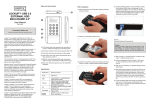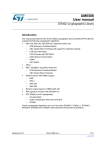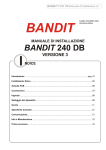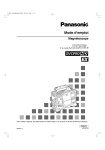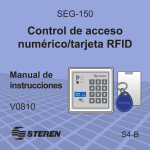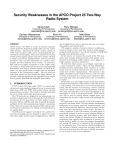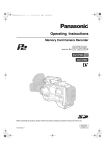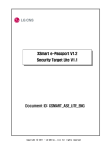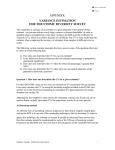Download InSiTo Library User Manual Version 1.1
Transcript
InSiTo Library User Manual
Version 1.1
Oliver Uwira
Falko Strenzke
Martin Döring
August 13th, 2008
Contents
1 Introduction
1.1 Purpose of this document . . . . . . . . . . . . . . . . . . . . . .
1.2 How to use this manual . . . . . . . . . . . . . . . . . . . . . . .
3
3
3
2 Building the Library
4
3 Global Configuration
3.1 Default Configuration . . . . . . . . . . . . . . . . . . . . . . . .
3.2 User defined Configuration . . . . . . . . . . . . . . . . . . . . .
7
7
7
4 Working with data
4.1 Information flow – pipes and filters . . . . . . . . . . . . . . . . .
4.2 Data input and output . . . . . . . . . . . . . . . . . . . . . . . .
8
8
8
5 Symmetric Algorithms
10
5.1 Message Digests . . . . . . . . . . . . . . . . . . . . . . . . . . . 10
5.2 Message Authentication Codes . . . . . . . . . . . . . . . . . . . 11
5.3 Block Ciphers . . . . . . . . . . . . . . . . . . . . . . . . . . . . . 11
6 Asymmetric Algorithms
6.1 Asymmetric Ciphers . . . . .
6.2 Digital Signature Algorithms
6.3 Key Agreement Algorithms .
6.4 Using Elliptic Curves . . . . .
.
.
.
.
.
.
.
.
.
.
.
.
.
.
.
.
.
.
.
.
.
.
.
.
.
.
.
.
.
.
.
.
.
.
.
.
.
.
.
.
.
.
.
.
.
.
.
.
.
.
.
.
.
.
.
.
.
.
.
.
.
.
.
.
.
.
.
.
.
.
.
.
.
.
.
.
.
.
.
.
13
14
15
17
19
7 Random Number Generation
21
8 Key Storage
22
1
9 X509 Certificates
9.1 Creating a CA certificate . . .
9.2 Creating a CA object . . . . .
9.3 Creating a certificate request .
9.4 Creating a certificate . . . . . .
9.5 Creating and Using CRLs . . .
9.6 Storing and loading certificates
.
.
.
.
.
.
.
.
.
.
.
.
.
.
.
.
.
.
.
.
.
.
.
.
.
.
.
.
.
.
.
.
.
.
.
.
23
23
23
24
24
25
26
10 EAC 1.1 CV Certificates
10.1 Overview . . . . . . . . . . . . . . . . . . . . . . . . . .
10.2 Global Configuration . . . . . . . . . . . . . . . . . . . .
10.3 Examples . . . . . . . . . . . . . . . . . . . . . . . . . .
10.3.1 Creation of CVCA . . . . . . . . . . . . . . . . .
10.3.2 Creating a link certificate . . . . . . . . . . . . .
10.3.3 Creating an unsigned DVCA request . . . . . . .
10.3.4 Creating an ADO DVCA request . . . . . . . . .
10.3.5 Signing DVCA requests . . . . . . . . . . . . . .
10.3.6 Verifying and signing ADO requests . . . . . . .
10.3.7 IS requests and IS ADO requests . . . . . . . . .
10.3.8 Writing a certificate file to disk in DER format .
10.3.9 Loading a DER encoded certificate file from disk
.
.
.
.
.
.
.
.
.
.
.
.
.
.
.
.
.
.
.
.
.
.
.
.
.
.
.
.
.
.
.
.
.
.
.
.
.
.
.
.
.
.
.
.
.
.
.
.
.
.
.
.
.
.
.
.
.
.
.
.
26
26
27
27
27
28
28
28
28
29
29
29
29
2
.
.
.
.
.
.
.
.
.
.
.
.
.
.
.
.
.
.
.
.
.
.
.
.
.
.
.
.
.
.
.
.
.
.
.
.
.
.
.
.
.
.
.
.
.
.
.
.
.
.
.
.
.
.
.
.
.
.
.
.
.
.
.
.
.
.
.
.
.
.
.
.
.
.
.
.
.
.
1
1.1
Introduction
Purpose of this document
This user manual is addressed to developers of applications requiring cryptographic functionality. The developers are supposed to know what functionality
they are about to use. This manual describes how the InSiTo library is supposed
to be used to obtain the required functionality.
The characteristics of the particular cryptographic algorithms provided by
the InSiTo library are not subject of this manual, which focusses primarily on
the aspect of programming. The reader is referred to cryptography handbooks
for more detailed information about the particular algorithms.
Although this manual is focussing on programming, it is not an API reference. Instead, this document provides the reader with a survey of the functionality of the InSiTo library by means of explained source code listings.
1.2
How to use this manual
In Section 3, the global configuration of the InSiTo library is described. Section 4
introduces the mechanisms through which the various algorithms of the InSiTo
library are provided with input data. From this section onwards, it will be
assumed that said mechanics are known. That is, in the case that code listings
would only differ in the input argument types passed to a function, this input
data will not be further commented, and the reader is referred to Section 4.
The remainder of this manual consists of thematic sections, each of which
covers one major group of cryptographic algorithms. The algorithms themselves
are explained by means of code listings that demonstrate how to perform the
usual operations associated with a particular algorithm. Following the description of these operations, the reader will find a reference of available algorithms
and their respective instantiation code, which is easily transferable to the code
listings mentioned above.
As an example, consider digital signatures. The code listing demonstrates
how to instantiate an algorithm as well as how to sign and verify input data.
This is followed by a list of available digital signature algorithms, the various parameters they require, and a demonstration of how to instantiate the respective
algorithm.
3
2
Building the Library
In order to build the InSiTo library, the following prerequisites have to be met:
• A working C++-compiler is installed. The following compilers have been
tested:
– Linux: GCC (the GNU C++-compiler), version 4.1.2
– Windows XP: MinGW version 5.1.3 (see http://www.mingw.org)
– Windows XP: Visual C++ 2008 Express Edition (see https://www.
microsoft.com/express/download). Both the IDE version and the
command line version (NMake) are supported.
• CMake (version ≥ 2.4) is installed (see http://www.cmake.org). Due to
an issue with the Windows version of CMake 2.6, the maximal supported
version of CMake for Windows XP is 2.4.8. Building has been tested with
version 2.4.8 for Windows and version 2.6 for Linux.
• Boost (version ≥ 1.34) is installed (see http://www.boost.org). Building
has been tested with versions 1.34 and 1.35.
We introduce the following shortcuts for different configurations:
• “GCC” denotes Linux with the GNU C++-compiler.
• “MinGW” denotes Windows XP with the MinGW compiler.
• “VS 2008” denotes Windows XP with the Visual C++ 2008 Express Edition IDE.
• ”NMake” denotes Windows XP with the command line compiler of the
Visual C++ 2008 Express Edition.
CMake is used to generate build files for the different compilers. To do so,
switch to the root of the InSiTo library sources. Then, type
• “cmake .” for GCC
• “cmake -G "MinGW Makefiles"” for MinGW
• “cmake -G "Visual Studio 9 2008"” for VS 2008
• “cmake -G "NMake Makefiles"” for NMake
Afterwards, start the CMake GUI as follows:
• “ccmake .” for Linux
• “cmakesetup .” for Windows XP
4
Now, a number of build options can be adjusted. In the following, we describe
the frequently needed options which are not self-explanatory.
• BUILD_SHARED, BUILD_STATIC: toggle whether to build a shared and static
version of the library, respectively. Note that the tests are always linked
to the shared version. When building for VS 2008, always enable both the
shared and the static version.
• Boost_INCLUDE_DIR: specify the location of the Boost header files on the
system. The directory specified here must contain the boost subdirectory
containing the headers.
• USE_TR1: specify which implementation of the TR1 functionality is used.
“std” chooses the implementation provided by the compiler (assuming that
it provides them in the first place), “boost” chooses the Boost implementation. The InSiTo library uses only the tr1/memory functionality from
TR1. Note that the application build against the library has to make the
same choice concerning the TR1 implementation to be used. Otherwise,
a problem with multiple definitions will arise during the compilation. For
information about TR1 see
http://aristeia.com/EC3E/TR1_info_frames.html.
• USE_INTERNAL_BOOST: choose whether the pre-built Boost libraries
shipped with the InSiTo-library shall be used. Pre-built libraries are
only available for Windows. To use these libraries, set this option
to “yes”. If setting this option to “no” for Windows XP, the Boost
library boost_unit_test_ framework has to be built and installed
(needed for the tests to compile). For Linux, the Boost libraries
boost_unit_test_framework and referenced libraries therein have to be
built and installed (needed for the tests to compile). So it is advised to install the full set of the boost libraries (http://www.boost.org/). Either
version 1.34 or 1.35 will do fine.
For the Linux version of CMake, a help for the currently selected option can be
displayed by pressing “h”, making it possible to read the full description of a
property (which might be cut off in the main screen). To modify a parameter
value, press “return”. Pressing “return” again confirms the new value. Once all
build parameters are adjusted, press “c”, then “g”.
For Windows, options can be selected with the mouse. When moving the
mouse over an option, an explanation is shown. Once all build parameters are
adjusted, press “Configure”, then “OK”. Finally, shut down the CMake GUI.
After all build parameters are set, the library is built as follows:
• GCC: execute “make”.
• MinGW: execute “mingw32-make”.
• NMake: execute “nmake”.
5
• VS 2008: open the generated “BOTAN.sln” solution file with the
Visual Studio IDE. Build the projects “insito-bib-1.7.2” and
“insito-bib_static-1.7.2. Note that in case of the debug build, the
string _d is appended to the projects’ and resulting files’ names. Afterwards, rename the built library file <...>_static<...>.lib: remove the
string _static from the file’s name.
For VS 2008, it is advised to disable the compiler warnings 4244, 4250, and
4290 for all projects contained in the “BOTAN.sln” solution.
The tests are built as follows:
• GCC/MinGW/NMake: execute “make/mingw32-make/nmake tests”.
• VS 2008: build the “tests” project. Afterwards, copy the following files
to the InSiTo base dir:
– from the Release or Debug directory (depends on the build
type you chose) the files tests.exe, insito-bib<...>.dll and
insito-bib<...>.lib;
– all files in the misc/lib/win32_vs2008 directory.
The original Botan tests are built with
• GCC/MinGW/NMake: execute “make/mingw32-make/nmake check”.
• VS 2008: build the “check project”.
This also allows benchmarking of certain algorithms.
To run the tests, execute either of the following commands:
• ./tests
• ./check --validate
• ./check --benchmark
For Windows XP, the “pthread” library is needed in order to run the “tests”
program. Pre-built libraries for MinGW and VS 2008 are shipped with the
InSiTo library. They have to be copied into the same directory as the “tests”
executable. To do so, type
• MinGW: copy misc\lib\win32_mingw\pthreadGCE2.dll .
• VS 2008: copy misc\lib\win32_vs2008\pthreadVCE2.dll .
For Linux, to install the headers and the library, execute the following command
with root privileges:
make install
For Windows, the library is contained in the root of the InSiTo library sources.
The headers are in the build/include/ subdirectory.
6
3
Global Configuration
3.1
Default Configuration
The InSiTo library uses a centralized global set of configuration parameters in
the form of key-value pairs. If no user defined configuration is provided, the
InSiTo library will use the default configuration, defined in the file policy.cpp.
As can be seen from this file, the keys of the configuration parameters are
divided into different sections, such as x509 or x509/ca. Finally, the full key is
defined by an additional key name, e.g. x509/ca/default_expire.
3.2
User defined Configuration
To use a user defined configuration, a text file of the following form has to be
created:
[<section name>]
<key 1> = <value for key 1>
<key 2> = <value for key 2>
.
.
.
An example excerpt from such a file would be:
[x509/ca]
allow_ca
basic_constraints
default_expire
signing_offset
=
=
=
=
false
always
1y
30s
# default expiry time for new certs
# offset the PKCS #10 validity times
by this amount
As it can be seen, comments can be provided after a # character.
Note that all keys that can be found in the file policy.cpp should appear
in the the text file with the user configuration. Otherwise, runtime errors might
occur because of missing entries.
To tell the InSiTo library that it should use the text file with the user
defined configuration instead of the default configuration, a constructor of the
LibraryInitializer has to be called with a specific argument:
Botan::InitializerOptions init_options("config=<filename>");
where <filename> has to be replaced by the name (including path) to the
configuration file.
7
4
Working with data
4.1
Information flow – pipes and filters
Many common uses of cryptography involve processing one or more streams of
data (be it from sockets, files, or hardware devices). The InSiTo library provides
a mechanism which facilitates setting up data flows through various operations,
such as compression, encryption, and base64 encoding.
Each of these operations is implemented in what are called filters in the
terminology of the InSiTo library. A set of filters are created and placed into
a pipe. Information ”flows” through the pipe, being passed from one filter to
the next, until the end of the pipe is reached, where the output is collected for
retrieval.
This design is similar to the usage of pipes in the Unix shell environment.
To demonstrate the usage of pipes in the InSiTo library, the following listing
shows an example, which uses a pipe to base64-encode some strings:
Pipe pipe ( create_shared_ptr < Base64_Encoder >() ) ;
pipe . start_msg () ;
pipe . write (" message 1") ;
pipe . end_msg () ;
// process_msg ( x ) is a short form for start_msg () &&
write ( x ) && end_msg ()
pipe . process_msg (" message2 ") ;
// first encoded message
std :: string m1 = pipe . re ad _a ll _as _s tr in g (0) ;
// second encoded message
std :: string m2 = pipe . re ad _a ll _as _s tr in g (1) ;
The pipe constructor is passed a std::tr1::shared_ptr<Filter>. This
is the major difference between the InSiTo library and its base library Botan,
which only supports ordinary C/C++ pointers and thus leaves the task of freeing
allocated memory to the programmer. Apart from this difference, the pipe API
of the InSiTo library is the same as in Botan, and therefore we refer the reader
to the Botan API reference for more detailed information about pipes.
4.2
Data input and output
The member functions Pipe::write() and Pipe::process_msg() are overloaded to support various means of passing data to a pipe. These are:
• void Pipe::write(const byte input[], u32bit length) – Write the
content of a byte array into the pipe. The second argument specifies the
number of bytes to be written.
• void Pipe::write(const MemoryRegion<byte>& input) – Write the
content of a memory region into a pipe. The MemoryRegion<T> class
8
is the base class of container classes such as SecureVector<T>. All
classes derived from MemoryRegion<T> implement secure memory management. That is, swapping of virtual memory pages occupied by a
MemoryRegion<T> to the hard disk is prevented, which keeps sensible data
in non-permanent storage only.
• void Pipe::write(const std::string& str) – Write a string into a
pipe. This is more of a convenience method, because normally data representations based on a stream of bytes are much closer to the real-life
applications of the library.
• void Pipe::write(DataSource& source) – Write a data source into
a pipe.
Data sources are a group of interfaces specified in
botan/data_src.h, that should be implemented by any data stream
classes that an application using InSiTo might specify. Doing this will
allow the writing of those streams into a pipe. Note that a Pipe is itself
derived from DataSource.
• void Pipe::write(byte input) – Write a single byte into the pipe. This
is the only overloaded version of Pipe::write() that does not have an
equivalent version of Pipe::process_msg().
For reading the results of a pipe operation, the following member functions
can be used. Every member function listed below specifies an u32bit-argument
that serves as an index into the list of processed messages of the pipe (please
see the example listing in Section 4.1).
• u32bit Pipe::read(byte& out, u32bit msg) – Read a single byte from
the specified message. The number of read bytes is returned.
• u32bit Pipe::read(byte output[], u32bit length, u32bit msg) –
Read a number of bytes, specified by the second argument, from the specified message. The number of read bytes is returned.
• SecureVector<byte> Pipe::read_all(u32bit msg) – Read a complete
message into a SecureVector<byte>.
• std::string Pipe::read_all_as_string(u32bit msg) – Read a complete message into a std:string.
Reading data out of a pipe will advance the pipe, such that the read data
cannot be read again. Therefore, potential lookahead functionality cannot be
implemented by means of the read()-functions. Instead, Pipe provides a group
of related peek()-functions, which will not be discussed here in further detail.
9
5
Symmetric Algorithms
Symmetric algorithms provided by the InSiTo library cover block cipher algorithms, message authentication codes (MACs), and message digests (hash
functions),
Except for message digests, which require no cryptographic key at all, the
keys used by the various algorithms are of the type SymmetricKey. This type
implements an octet string of variable length. The class provides a constructor
that takes the number of bytes (i.e octets). This constructor may be used to
create random octet string keys as needed.
5.1
Message Digests
Message digests are computed by means of a Hash_Filter, which can be used
with a Pipe. The code listing below demonstrates how message digests of the
InSiTo library are computed:
# include < botan / api / botan .h >
...
std :: string text = " message ";
std :: string md ;
...
Pipe pipe ( create_shared_ptr < Hash_Filter >(" SHA -1") ,
create_shared_ptr < Hex_Encoder >() ) ;
pipe . process_msg ( text ) ;
md = pipe . r ea d_ al l_ as _s tr in g (0) ;
A std::tr1::shared_ptr<Hash_Filter> is created by using the template
function create_shared_ptr<T>(). The arguments passed to this function are
passed to the respective constructors of the class T. In case of a Hash_Filter,
the constructor must be passed a string alias of the required algorithm.
The following message digests are provided by the InSiTo library:
• SHA-1
• SHA-224
• SHA-256
• SHA-384
• SHA-512
• RIPEMD-160
These codes are also used as string aliases with create_shared_ptr<Hash_
Filter>().
10
5.2
Message Authentication Codes
Message authentication codes (MACs) are computed by means of a MAC_Filter,
which can be used with a Pipe. The code listing below demonstrates how the
MACs of the InSiTo library are computed:
# include < botan / api / botan .h >
...
std :: string text = " message ";
std :: string mac ;
...
// create a symmetric key of size 20 byte
SymmetricKey key (20) ;
Pipe pipe ( create_shared_ptr < MAC_Filter >(" HMAC ( SHA -1) " ,
key ) ,
create_shared_ptr < Hex_Encoder >() ) ;
pipe . process_msg ( text ) ;
mac = pipe . re ad _a ll _as _s tr in g (0) ;
A std::tr1::shared_ptr<MAC_Filter> is created by using the template
function create_shared_ptr<T>(). The arguments passed to this function are
passed to the respective constructors of the class T. In case of a MAC_Filter,
the constructor must be passed a string alias of the required algorithm and a
SymmetricKey.
The following MACs are provided by the InSiTo library:
• HMAC (in combination with a message digest)
• CBC-MAC (in combination with a block cipher)
• CMAC (in combination with a block cipher)
These codes are also used as string aliases with create_shared_ptr<MAC_
Filter>().
As can be seen in the listing above, the string alias of HMAC is constructed
by appending a message digest alias in braces. The same is valid for CBC-MAC
and CMAC, but for these algorithms, a block cipher must be specified in braces
instead of a message digest, e.g CMAC(AES).
The list of available message digest aliases is given in Section 5.1. The block
cipher aliases are given in Section 5.3.
5.3
Block Ciphers
Block ciphers are computed by means of a Keyed_Filter, which can be used
with a Pipe. The code listing below demonstrates how block ciphers of the
11
InSiTo library are used:
# include < botan / api / botan .h >
std :: string text = " message ";
...
// Create a symmetric key of size 16 bytes
SymmetricKey key (16) ;
// Create an initialization vector of size 16 bytes
I n i t i a l i z a t i o n V e c t o r iv (16) ;
Pipe enc_pipe ( get_cipher (" AES / CBC / NoPadding " , key , iv ,
ENCRYPTION ) ,
create_shared_ptr < Hex_Encoder >() ) ;
enc_pipe . process_msg ( text ) ;
SecureVector < byte > ciphertext = enc_pipe . read_all (0) ;
Pipe dec_pipe ( create_shared_ptr < Hex_Decoder >() ,
get_cipher (" AES / CBC / NoPadding " , key , iv ,
DECRYPTION ) ) ;
dec_pipe . process_msg ( ciphertext ) ;
SecureVector < byte > plaintext = dec_pipe . read_all (0) ;
A std::tr1::shared_ptr<Keyed_Filter> is created by using the global
function get_cipher(). The arguments passed to this function are:
• const std::string& algo_spec – The algorithm alias
• const SymmetricKey& key – The symmetric key
• const InitializationVector& iv – The initialization vector
• Cipher_Dir direction – The direction of the cipher operation. Cipher_
Dir is an enum that specifies two directions: ENCRYPTION and DECRYPTION.
The following block cipher algorithms are provided by the InSiTo library:
• TripleDES (key length of 168 bits)
• AES (supports key lengths of 128 bits, 192 bits and 256 bits)
The algorithm alias string for a block cipher is of the form ALGORITHM/MODE/
PADDING. If any part of the alias except for ALGORITHM is omitted, defaults will
be used. The following modes are provided by the InSiTo library:
12
• ECB
• CBC
• CFB
• OFB
• CTR
These codes are also used as string aliases for MODE. The following padding
methods are provided by the InSiTo library:
• PKCS7
• OneAndZeros
• X9.23
• NoPadding
These codes are also used as string aliases for PADDING.
6
Asymmetric Algorithms
Asymmetric algorithms provided by the InSiTo library cover asymmetric cipher
(encryption) algorithms, digital signatures, and key agreement schemes.
The public and private keys used by the various algorithms are of the type
Public_Key and Private_Key, respectively. In the InSiTo library, Private_Key
is a subclass of Public_Key and encapsulates all the information that is needed
by its associated algorithm. This design allows for a very easy method of obtaining a key pair, which is demonstrated in the next listing:
# include < botan / api / rsa .h >
...
// Create an RSA private key of size 1024 bits
RSA_PrivateKey prv_key (1024) ;
// Create the corresponding RSA public key object via
a cast to the super type
RSA_PublicKey pub_key = prv_key ;
13
6.1
Asymmetric Ciphers
The InSiTo library provides one asymmetric cipher algorithm, RSA, and two
encoding methods, PKCS1v15 and RSA-OAEP. It is also possible to use the algorithm in raw mode.
Asymmetric ciphers are computed by means of two special objects, PK_
Encryptor and PK_Decryptor. These are used to construct the suitable Filter
classes, PK_Encryptor_Filter and PK_Decryptor_Filter, which can be used
with a Pipe.
The code listing below demonstrates how asymmetric ciphers of the InSiTo
library are used:
# include < botan / api / botan .h >
# include < botan / api / look_pk .h >
# include < botan / api / rsa .h >
...
std :: string plaintext = " message ";
std :: string ciphertext ;
...
// Create an RSA private key of size 1024 bits
RSA_PrivateKey prv_key (1024) ;
// Create PK_Encryptor and PK_Decryptor filters
std :: auto_ptr < PK_Encryptor > enc_aptr =
get_pk_encryptor ( prv_key , " PKCS1v15 ") ;
std :: auto_ptr < PK_Decryptor > dec_aptr =
get_pk_decryptor ( prv_key , " PKCS1v15 ") ;
std :: tr1 :: shared_ptr < PK_Encryptor > enc ( enc_aptr ) ;
std :: tr1 :: shared_ptr < PK_Decryptor > dec ( dec_aptr ) ;
// Encrypt the plaintext
Pipe enc_pipe ( create_shared_ptr < PK_Encryptor_Filter >(
enc ) ,
create_shared_ptr < Hex_Encoder >() ) ;
enc_pipe . process_msg ( plaintext ) ;
ciphertext = enc_pipe . r ea d_a ll _a s_ st ri ng (0) ;
// Decrypt the ciphertext
Pipe dec_pipe ( create_shared_ptr < Hex_Decoder >() ,
create_shared_ptr < PK_Decryptor_Filter >(
dec ) ) ;
dec_pipe . process_msg ( ciphertext ) ;
14
plaintext = dec_pipe . re ad _a ll _a s_ st ri ng (0) ;
A std::tr1::shared_ptr<PK_Encryptor> is created by passing the result
of the global function get_pk_encryptor() to the constructor of std::tr1::
shared_ptr<PK_Encryptor>. A std::tr1::shared_ptr<PK_Decryptor> is
created by using the global function get_pk_decrpytor().
The arguments passed to get_pk_encryptor() are:
• const PK_Encrypting_Key& key – An encrypting key suitable for the
specified algorithm
• const std::string& eme – A string alias for an encoding method.
The arguments passed to get_pk_decryptor() are:
• const PK_Decrypting_Key& key – An encrypting key suitable for the
specified algorithm
• const std::string& eme – A string alias for an encoding method.
The following encoding methods are provided by the InSiTo library.
• Raw – no encoding will be used
• PKCS1v15 – PKCS #1 v1.5 encoding
• EME1 – OAEP (PKCS #1 v2.1) encoding (in combination with a message
digest)
A string alias of the OAEP encoding method is constructed by appending
a message digest alias in braces. This is analogous to the creation of message
authentication code filters described in Section 5.2. The list of available message
digest aliases is given in Section 5.1.
6.2
Digital Signature Algorithms
The InSiTo library provides two digital signatures, RSA and ECDSA. For RSA,
the encoding methods PKCS1v15 and RSA-PSS are available. It is also possible
to use RSA in raw mode. EC-DSA supports EMSA1 and EMSA1 BSI encoding.
The latter is a non standard or respectively future standard encoding variant
and is explained in Section 6.4.
Digital signatures are computed by means of two special objects, PK_Signer
and PK_Verifier. These are used to construct the suitable Filter classes,
PK_Signer_Filter and PK_Verifier_Filter, which can be used with a Pipe.
The code listing below demonstrates how digital signatures of the InSiTo
library are used:
15
# include < botan / api / botan .h >
# include < botan / api / look_pk .h >
# include < botan / api / rsa .h >
...
std :: string text = " message ";
...
// Create an RSA key pair
RSA_PrivateKey prv_key (1024) ;
RSA_PublicKey pub_key = prv_key ;
// Create PK_Signer and PK_Verifier filters
std :: auto_ptr < PK_Signer > sig_aptr = get_pk_signer (
prv_key , " Raw ") ;
std :: tr1 :: shared_ptr < PK_Signer > signer ( sig_aptr ) ;
std :: auto_ptr < PK_Verifier > ver_aptr = get_pk_verifier (
prv_key , " Raw ") ;
std :: tr1 :: shared_ptr < PK_Verifier > verifier ( ver_aptr ) ;
// Sign the message
Pipe sig_pipe ( create_shared_ptr < PK_Signer_Filter >(
signer ) ) ;
sig_pipe . process_msg ( text ) ;
SecureVector < byte > sig_bytes = sig_pipe . read_all (0) ;
// Verify the signature
// Create a P K_ Ve ri fi er _F il te r by passing a
PK_Verifier AND the digital signature
Pipe ver_pipe ( create_shared_ptr < PK_Verifier_Filter >(
verifier , sig_bytes ) ) ;
ver_pipe . process_msg ( text ) ;
SecureVector < byte > ver_result = ver_pipe . read_all (0) ;
A std::tr1::shared_ptr<PK_Signer> is created by passing the result of
the global function get_pk_signer() to the constructor of std::tr1::shared_
ptr<PK_Signer>. The arguments passed to get_pk_signer() are:
• const PK_Signing_Key& key – An signing key suitable for the specified
algorithm
• const std::string& eme – A string alias for an encoding method.
• Signature_Format sig_format – The signature format. Signature_
Format is an enum that specifies two formats: IEEE_1363, which is the
default argument, and DER_SEQUENCE.
16
A std::tr1::shared_ptr<PK_Decryptor> is created by using the global function get_pk_verifier() respectively. The arguments of get_pk_verifier()
are:
• const PK_Verifying_with_MR_Key& key – An verifying key suitable for
the specified algorithm
• const std::string& eme – A string alias for an encoding method.
• Signature_Format sig_format – see get_pk_signer() above
In order to create a PK_Verifier_Filter, the digital signature must be passed
to the constructor along with the PK_Verifier.
Please note: The code listing uses the RSA algorithm and therefore RSA
keys are generated in the beginning. For using the EC-DSA algorithm, ECDSA keys must be used. These keys are of the types ECDSA_PublicKey and
ECDSA_PrivateKey. Once these keys are available, the process of calculating
and verifying signatures is analogous to the way shown in the listing. Please see
Section 6.4 for information about the usage of elliptic curve functionality of the
InSiTo library.
6.3
Key Agreement Algorithms
The InSiTo library provides two variations of a Diffie-Hellman key agreement
scheme. One scheme (PKCS #3) operates on a classical (Z/pZ)∗ group, whereas
the other one (EC-KAEG) operates on an elliptic curve point group.
The operations necessary to compute a shared secret are encapsulated by
the class PK_Key_Agreement. Any party involved in a key agreement process
can use a PK_Key_Agreement object to update received public data and, finally,
compute the shared secret.
The code listing below demonstrates how key agreement schemes of the
InSiTo library are used:
# include < botan / api / botan .h >
# include < botan / api / look_pk .h >
# include < botan / api / dh .h >
...
// Create the public and private values for the
// key agreement scheme . Its participants be
// Alice and Bob .
// We also create a domain . In this case , we will use
// the ( Z / nZ ) * method and therefore the domain is a
// DL_Group object .
DL_Group domain (" modp / ietf /1024") ;
17
DH_PrivateKey prv_key_alice ( domain ) ;
DH_PublicKey pub_key_alice = prv_key_alice ;
DH_PrivateKey prv_key_bob ( domain ) ;
DH_PublicKey pub_key_bob = prv_key_bob ;
// Create the PK_Key_Agreement objects for Alice and
Bob
std :: auto_ptr < PK_Key_Agreement > kas_alice_aptr =
get_pk_kas ( prv_key_alice , " Raw ") ;
std :: tr1 :: shared_ptr < PK_Key_Agreement > kas_alice (
kas_alice_aptr ) ;
std :: auto_ptr < PK_Key_Agreement > kas_bob_aptr =
get_pk_kas ( prv_key_bob , " Raw ") ;
std :: tr1 :: shared_ptr < PK_Key_Agreement > kas_bob (
kas_bob_aptr ) ;
// Use the PK_Key_Agreement object to derive a
symmetric key .
// The computation of the shared secret and the
derivation of the symmetric key are bundled by the
PK_Key_Agreement object .
SymmetricKey sym_key_alice = kas_alice - > derive_key (16 ,
pub_key_bob ) ;
// Repeat the last step for Bob . The results are equal
.
SymmetricKey sym_key_bob = kas_bob - > derive_key (16 ,
pub_key_alice ) ;
A std::tr1::shared_ptr<PK_Key_Agreement> is created by passing the
result of the global function get_pk_kas() to the constructor of std::tr1::
shared_ptr<PK_Key_Agreement>.
The arguments passed to get_pk_kas() are:
• const PK_Key_Agreement_Key& key – A (private) key agreement key
suitable for the specified algorithm
• const std::string& kdf – A string alias for a key derivation function
The following key derivation methods are provided by the InSiTo library:
• Raw
18
• KDF1
• KDF2
• X9.42-PRF
The InSiTo library also provides some built-in (Z/pZ)∗ groups of different size,
which can be instantiated by passing a group identifier to the constructor of
DL_Group. The following group identifiers can be used:
• modp/ietf/768 (768 bits)
• modp/ietf/1024 (1024 bits)
• modp/ietf/1536 (1536 bits)
• modp/ietf/2048 (2048 bits)
• modp/ietf/3072 (3072 bits)
• modp/ietf/4096 (4096 bits)
Please note: The code listing uses a (Z/pZ)∗ group as the domain of the
key agreement scheme (PKCS #3). Therefore, keys of the types DH_PrivateKey
and DH_PublicKey are generated in the beginning. For using the ECKAEG
algorithm, ECKAEG keys must be used. These keys are of the types ECKAEG_
PublicKey and ECKAEG_PrivateKey. Once these keys are available, the process
of computing the shared secret and deriving a symmetric key is analogous to
the way shown in the listing. Please see Section 6.4 for information about the
usage of elliptic curve functionality of the InSiTo library.
6.4
Using Elliptic Curves
The InSiTo library also provides seven standard elliptic curve point groups,
which can be instantiated by passing the OID of the curve to the global function
get_EC_Dom_Pars_by_oid(). These standard curves and their OIDs are:
• OID = "1.3.36.3.3.2.8.1.1.1" (BrainpoolP160r1)
• OID = "1.3.36.3.3.2.8.1.1.3" (BrainpoolP192r1)
• OID = "1.3.36.3.3.2.8.1.1.5" (BrainpoolP224r1)
• OID = "1.3.36.3.3.2.8.1.1.7" (BrainpoolP256r1)
• OID = "1.3.36.3.3.2.8.1.1.9" (BrainpoolP320r1)
• OID = "1.3.36.3.3.2.8.1.1.11" (BrainpoolP384r1)
• OID = "1.3.36.3.3.2.8.1.1.13" (BrainpoolP512r1)
19
Once an elliptic curve has been instantiated, it can be used to create keys for
either the EC-KAEG key agreement scheme or the EC-DSA digital signature.
The process is demonstrated in the following listing:
# include
# include
# include
# include
< botan / api / botan .h >
< botan / api / look_pk .h >
< botan / api / ec .h >
< botan / api / ec_dompar .h >
// Create an elliptic curve
EC_Domain_Params dom_pars = g e t _ E C _ D o m _ P a r s _ b y _ o i d
("1.3.36.3.3.2.8.1.1.1") ;
// Create keys for EC - DSA digital signature algorithm .
// Further proceeding is similar to the RSA digital
signature algorithm described before .
ECDSA_PrivateKey prv_key ( dom_pars ) ;
ECDSA_PublicKey pub_key = prv_key ;
// Create keys for EC - KAEG key agreement scheme
// Further proceeding is similar to the PCKS #3 key
agreement scheme described before .
ECK AEG_Pr ivateK ey prv_key_alice ( dom_pars ) ;
ECKAEG_PublicKey pub_key_alice = prv_key_alice ;
Once the elliptic curve and the EC-DSA or EC-KAEG keys have been created, the further process is analogous to the RSA digital signature (see Section 6.2) and the PKCS #3 key agreement scheme (see Section 6.3), respectively.
Signature Encoding Besides the standardized signature encoding methods
like EMSA1, EMSA2, etc., the InSiTo library supports a yet non standardized
method named EMSA1 BSI. In contrast to EMSA1, this encoding type does
not allow for the length of the output of the hash function to be larger than the
input size of the core signature algorithm. For ECDSA, this means that the bit
length of the order of the base point must be at least equal to the bit length of
the output of the chosen hash function, otherwise an exception will be thrown
when attempting to perform a signing or verifying operation with the signer or
verifier.
To create a PK_Signer using this encoding, simply type
auto_ptr < Botan :: PK_Signer > pk_signer = Botan :: get_pk_signer ( priv_key , " EM
In the default global configuration, this encoding is associated with the
ECDSA OIDs. To override this, you have to provide your own configuration.
See section 3 to learn how to do this.
20
7
Random Number Generation
The InSiTo library provides three pseudo random number generators:
• the PRNG defined in ANSI X9.31, Appendix A,
• BBS and
• SHA1-PRNG.
Both generators need a seeded base random number generator as an entropy
source. Attempting to use any random number generator unseeded will cause an
exception. For more detailed information about the random number generation
of the InSiTo library, the reader is referred to the API documentation of the
base library Botan.
The code listing below demonstrates how random number generators of the
InSiTo library are used:
# include
# include
# include
# include
< botan / api / botan .h >
< botan / api / base .h >
< botan / int / bbs .h >
< botan / int / randpool .h >
# define SEEDLEN 600
# define RNUMLEN 20
...
byte seed [ SEEDLEN ] = {0 ,0 ,0 , ... ,0};
byte out [ RNUMLEN ] = {0 ,0 ,0 , ... ,0};
...
// Create a base random number generator and seed it .
// Note that an exception will also be thrown here if
the seed length is too small .
std :: tr1 :: shared_ptr < RandomNumberGenerator > rn_ptr ( new
Randpool () ) ;
rn_ptr - > add_entropy ( seed , SEEDLEN ) ;
// Create a BBS random number generator and seed it .
// Note that an exception will also be thrown here if
the seed length is too small .
R a n d o m N u m b e r G e n e r a t o r * rng = ( R a n d o m N u m b e r G e n e r a t o r *) (
new BBS ( rn_ptr ) ) ;
rng - > add_entropy ( seed , SEEDLEN ) ;
// Randomize the contents of the byte array out [].
21
// The contents of the array can be interpreted as a
random number of the size ( in bytes ) of RNUMLEN
rng - > randomize ( out , RNUMLEN ) ;
// Delete the RNG after usage because we have not used
a smart pointer but an ordinary C / C ++ pointer .
delete rng ;
For instantiating a SHA1-PRNG, we would simply use the SHA1PRNG constructor instead of the BBS constructor:
RandomNumberGenerator* rng =
(RandomNumberGenerator*)(new SHA1PRNG());
Both constructors also have a default argument, which will result in the
usage of the global random number generator of the InSiTo library as the base
random number generator.
8
Key Storage
For storing key objects of the InSiTo library, two encoding methods are provided:
PEM and DER. The following functions (declared in the header file botan/x509_
keys.h) can be used to encode key objects:
• void encode(const Public_Key key&, Pipe& pipe, X509_Encoding
encoding) – Encode a Public_Key in the specified X509_Encoding and
pass the encoded key into a Pipe. Possible encodings are PEM, which is
the default argument, and RAW_BER (i.e DER).
• The following overloaded functions, each returning a std::auto_ptr
<Public_Key>:
– load_key(std::tr1::shared_ptr<DataSource>& source) – load
key from a data source
– load_key(const std::string& fsname) – load key from a file with
the given filename
– load_key(const MemoryRegion<byte>& mem) – load key from a
memory region
# include < botan / x509_keys .h >
# include < botan / rsa .h >
...
RSA_PrivateKey prv_key (1024) ;
RSA_PublicKey pub_key = prv_key
22
// PEM encode pub_key
// A pipe without filters
Pipe pipe () ;
pipe . start_msg () ;
X509 :: encode ( pub_key , pipe ) ;
pipe . end_msg () ;
// Reload pub_key from pipe
// Note : Pipe is derived from DataSource
std :: auto_ptr < PublicKey > pub_key_aptr = load_key ( pipe )
;
9
X509 Certificates
9.1
Creating a CA certificate
In the InSiTo library, a CA certificate can be created by using the function
X509_Certificate X509::create_self_signed_cert(). The method takes
the following arguments:
• const X509_Cert_Options& opts – certificate parameters
• const Private_Key& key – the private key of the CA
The following listing demonstrates the use of this function:
// Create Certificate options
X50 9_Cert _Optio ns ca_opts (" Test CA / DE / InSiTo / Examples
") ;
ca_opts . uri = " http :// botan . randombit . net ";
ca_opts . dns = " botan . randombit . net ";
ca_opts . email = " te sting@ random bit . net ";
ca_opts . CA_key (1) ;
// Create a private key for the CA
RSA_PrivateKey prv_key_ca (1024) ;
// Create the CA certificate by self - signing
X509_Certificate cert_ca = X509 ::
c r e a t e _ s e l f _ s i g n e d _ c e r t ( ca_opts , prv_key_ca ) ;
9.2
Creating a CA object
A CA object is creating by passing the constructor of the class X509_CA the CA
certificate as well as the private key of the CA. The following listing demonstrates the use:
23
// Assume we have these objects from section 8.1
RSA_PrivateKey prv_key_ca = ...
X509_Certificate cert_ca = ...
// Create a CA object
X509_CA ca ( cert_ca , prv_key_ca ) ;
9.3
Creating a certificate request
In the InSiTo library, a certificate request can be created by using the function
PKCS10_Request X509::create_cert_req().
• const X509_Cert_Options& opts – certificate parameters
• const Private_Key& key – the private key to be certified
The following listing demonstrates the use of this function:
// Create Certificate options
X50 9_Cert _Optio ns req_opts_alice (" Test Alice / DE / InSiTo
/ Examples ") ;
req_opts_alice . uri = " http :// www . foobar . net ";
req_opts_alice . dns = " www . foobar . net ";
req_opts_alice . email = " alice@foobar . net ";
req_opts_alice . ad d_ex_c onstra int (" PKIX . EmailProtection
") ;
// Create a private key for the CA
RSA_PrivateKey prv_key_alice (768) ;
// Create a certificate request
PKCS10_Request req_alice = X509 :: create_cert_req (
req_opts_alice , prv_key_alice ) ;
9.4
Creating a certificate
A certificate can be created by letting a CA sign a certificate request. This can
be done by using the member function X509_Certificate X509_CA::sign_
request().
• const PKCS10_Request& req – the PCKCS #10 request object
• u32bit expire_time = 0
The following listing demonstrates this usage:
24
// Assume we have these objects from section 8.2 and
8.3 , respectively
X509_CA ca = ...
PKCS10_Request req_alice = ...
// Sign the request to create a certificate
X509_Certificate cert_alice = ca . sign_request (
req_alice ) ;
9.5
Creating and Using CRLs
The following listing demonstrates the following operations concerning CRLs:
• Creating a CRL
• Adding a CRL a certificate to a X509_Store key store object
• Revoking a certificate
// Assume we have these objects from section 8.2 and
8.4 , respectively
X509_CA ca = ...
X509_Certificate cert_alice = ...
// Create a new CRL
X509_CRL crl1 = ca . new_crl () ;
// Add the CRL and Alice ’ s certificate to a key store .
X509_Store store ;
store . add_cert ( cert_ca , true ) ; // second arg == true :
trusted CA cert
if ( store . add_crl ( crl1 ) != VERIFIED )
{
// CRL invalid
}
else
{
// CRL valid
}
if ( store . validate_cert ( cert_alice ) != VERIFIED )
{
// Alice ’ s certificate invalid
}
else
25
{
// Alice ’ s certificate valid
}
// Revoke Alice ’ s certificate
std :: vector < CRL_Entry > revoked ;
revoked . push_back ( cert_alice ) ;
X509_CRL crl2 = ca . update_crl ( crl1 , revoked ) ;
store . add_crl ( crl2 ) != VERIFIED
9.6
Storing and loading certificates
A certificate can be encoded by using the member functions
SecureVector<byte> BER_encode() const
or
std::string PEM_encode() const
for DER and PEM encoding, respectively. Loading a certificate is done by
passing the file name of an encoded certificate to the constructor of X509_
Certificate.
The following listing demonstrates this use:
// Assume we have this object from section 8.4
X509_Certificate cert_alice = ...
// Export Alice ’ certificate into a PEM encoded file
std :: ofstream x509_file (" cert_alice . pem " , std :: ios ::
binary ) ;
x509_file << cert_alice . PEM_encode () ;
x509_file . close () ;
// Import Alice ’ s certificate from a PEM encoded file
and validate it
X509_Certificate cert_tmp (" cert_alice . pem ") ;
10
EAC 1.1 CV Certificates
This section explains the use of the EAC 1.1 Card Verifiable Certificates (CVC).
10.1
Overview
InSiTo library supports the following EAC related objects:
CVC’s The CVC’s themselves are represented by the class EAC1_1_CVC.
26
CVC Requests CVC Requests, i.e. requests that only contain an internal self
signature, are represented by the class EAC1_1_Req.
CVC ADO Requests The signed CVC ADO Requests are represented by the
class EAC1_1_ADO.
The convenience functions intended for clients to use for the creation of the
above EAC objects are found in the file cvc_self.h. The functions therein are
divided into two namespaces: CVC_EAC and DE_EAC. The former contains the
lower level functions for the creation of general EAC objects, while the latter
specifically implements the german EAC rules (they build up on the former).
For a list and description of the EAC objects and the related convenience
functions, please refer to the API reference documentation.
In the following, examples are given for the use of the various EAC objects.
10.2
Global Configuration
The following global configuration parameters are used in the context of CVC’s:
• eac/ca/cvca_validity_months, defaults to 12,
• eac/ca/dvca_validity_months, defaults to 3,
• eac/ca/is_validity_months, defaults to 1.
10.3
10.3.1
Examples
Creation of CVCA
To create a CVCA, the user has to provide the EC_Domain_Params object and
create a private key for these domain parameters. Furthermore, the user has
to choose the hash algorithm used by this CA for signing and determine the
CAR/CHR value.
Botan :: EC_Domain_Params dom_pars ( Botan ::
get_EC_Dom_Pars_by_oid ("1.3.36.3.3.2.8.1.1.5") );
Botan :: ECDSA_PrivateKey cvca_privk ( dom_pars ) ;
string hash (" SHA -224") ;
Botan :: ASN1_Car car (" DECVCA00001 ") ;
Botan :: EAC1_1_CVC cvca_cert = Botan :: DE_EAC ::
create_cvca ( cvca_privk , hash , car , true , true ) ;
The last two boolean parameters are the ‘iris” and “fingerprint” flags that will be
incorporated in the certificate holder authorization (CHA). So in this example,
this CVCA will be allowed to read both biometric properties, and all certificates
signed with this CVCA will inherit this property.
27
10.3.2
Creating a link certificate
The following piece of code creates a link certificate between two CVCA certificates:
Botan :: EAC1_1_CVC link12 = Botan :: DE_EAC :: link_cvca (
cvca_cert1 , cvca_privk1 , cvca_cert2 ) ;
Here, the certificate cvca_cert1 (whose private key is cvca_privk1) signs the
link certificate with the certificate holder being cvca_cert2.
10.3.3
Creating an unsigned DVCA request
To create a DVCA request (in constrast to an ADO request, this object type
carries only a self signature), do the following:
Botan :: EC_Domain_Params dom_pars ( Botan ::
get_EC_Dom_Pars_by_oid ("1.3.36.3.3.2.8.1.1.5") );
string hash (" SHA -224") ;
Botan :: ECDSA_PrivateKey dvca_priv_key ( dom_pars ) ;
Botan :: EAC1_1_Req dvca_req = Botan :: DE_EAC ::
create_cvc_req ( dvca_private_key , Botan :: ASN1_Chr ("
DEDVCAEPASS ") , hash ) ;
10.3.4
Creating an ADO DVCA request
The following piece of code shows how to create an ADO request:
Botan :: EAC1_1_ADO dvca_ado2 = Botan :: CVC_EAC ::
create_ado_req ( dvca_priv_key , dvca_req , Botan ::
ASN1_Car ( dvca_cert1 . get_chr () . iso_8859 () ) ) ;
The ADO is created from the request object it encapsulates, the private key
to create the ADO signature, and the CAR. In the example code above,
dvca_cert1 is the certificate associated with the private key dvca_priv_key.
10.3.5
Signing DVCA requests
In order to sign a DVCA request with a CVCA, simply do the following:
Botan :: EAC1_1_CVC dvca_cert1 = Botan :: DE_EAC ::
sign_request ( cvca_cert , cvca_private_key , dvca_req ,
1 , 5 , true ) ;
Here, the first three parameters should be self-explanatory. The number 1
indicates the serial number of the request to be signed, whereas 5 indicates that
the serial number will be encoded in 5 digits and appended to the CHR found
in the request. The last boolean parameter indicates that this request is signed
as a domestic DVCA.
28
10.3.6
Verifying and signing ADO requests
The following piece of code shows how to perform the verification of outer ADO
signature. Assume that dvca_ado is the EAC1_1_ADO to be verified, and that
dvca_cert1 is the EAC1_1_CVC object that has signed the ADO.
auto_ptr < Botan :: Public_Key > ap_pk = dvca_cert1 .
su bj ec t_ pu bl ic _k ey () ;
Botan :: ECDSA_PublicKey * cert_pk = dynamic_cast < Botan ::
ECDSA_PublicKey * >( ap_pk . get () ) ;
cert_pk - > s e t _ d o m a i n _ p a r a m e t e r s ( dom_pars ) ;
dvca_ado . check_signature (* cert_pk )
Note that the function ECDSA_PublicKey::set_domain_parameters() is
called. This is necessary whenever a certificate without explicit domain parameters is loaded.
10.3.7
IS requests and IS ADO requests
The creation, verification, and signing of IS related requests works analogously
to the handling of DVCA requests. When letting a DVCA sign requests, it will
automatically sign them as IS requests, just as CVCA automatically treats all
requests as DVCA requests.
10.3.8
Writing a certificate file to disk in DER format
The following code shows how to write a certificate named cvca_cert to disk
in DER format:
ofstream cvca_file (" checks / temp / cvc_chain_cvca . cer " ,
ios :: binary ) ;
Botan :: SecureVector < Botan :: byte > cvca_sv = cvca_cert .
BER_encode () ;
cvca_file . write (( char *) cvca_sv . begin () , cvca_sv . size ()
);
cvca_file . close () ;
10.3.9
Loading a DER encoded certificate file from disk
The following code shows how to decode a DER encoded CVC from the disk:
Botan :: EAC1_1_CVC cert (" checks / testdata / cvca01 . cv . crt
") ;
The same constructors exist for requests and ADO requests.
Note that the public EC-DSA key of certificates can only be used when the
domain parameters are set. After an encoded CVC without domain parameters
is decoded, the certificate’s public key cannot be used. In this case, first call
the key’s member function ECDSA_PublicKey::set_domain_parameters() and
provide the associated domain parameters as the argument.
29





























